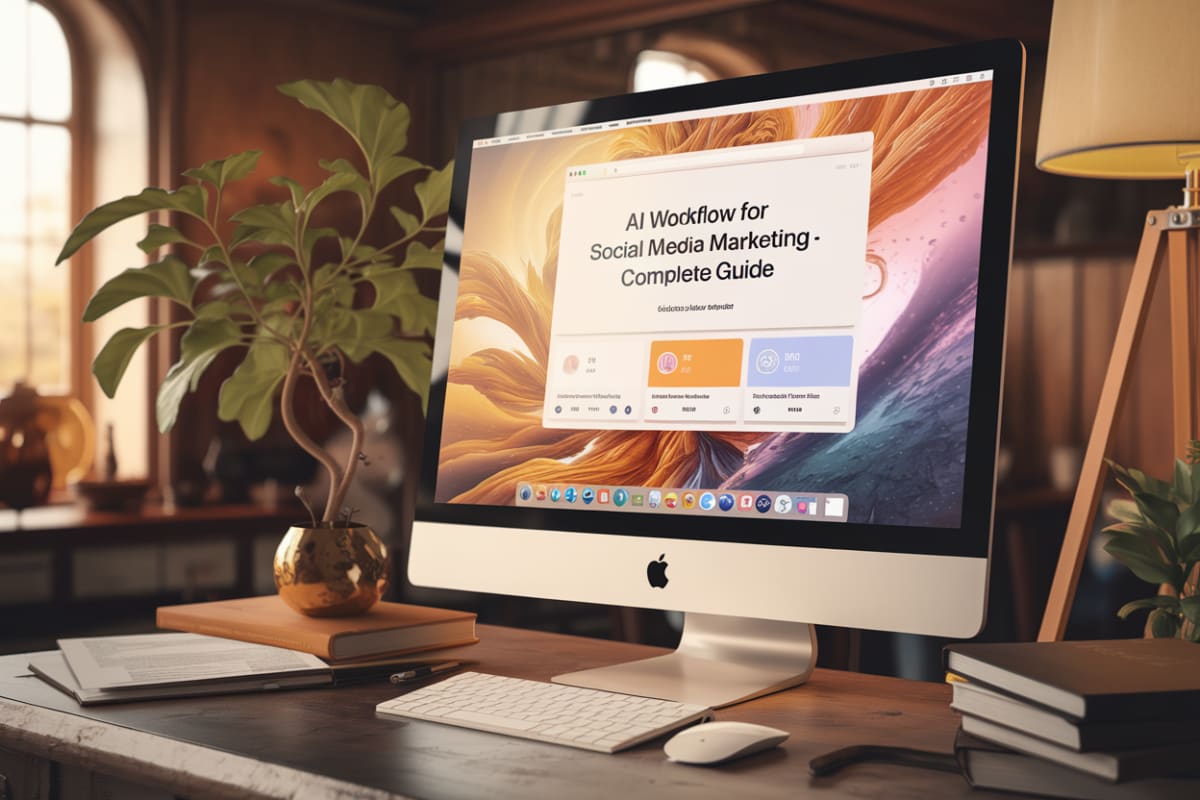Social Media Advertising: Complete Guide
What is Social Media Advertising?
Definition
Social media advertising involves brands paying to promote products or services on platforms like Facebook, Instagram, LinkedIn, and TikTok. This method differs from organic reach, which relies on unpaid posts for visibility. Paid ads target specific audiences, increasing the chances of engagement and conversions.
Key Features
- Targeting Specific Audiences: Advertisers micro-target users based on demographics, interests, and behaviors. For instance, Facebook enables advertisers to create ads for users fitting specific criteria such as age and location.
- Variety of Ad Formats: Social media platforms offer various ad formats, including image ads, video ads, carousel ads, and Stories ads. This diversity allows brands to select the format that aligns best with their marketing goals. For example, Instagram's Stories ads capture attention quickly with short, engaging content.
- Real-time Performance Monitoring: Advertisers track key metrics like reach, engagement rates, click-through rates (CTR), and conversions. This data allows real-time adjustments to campaigns, optimizing ad spend effectively. If an ad performs well, marketers can increase its budget to maximize exposure.
Benefits
- Increased Brand Awareness: Social media advertising boosts visibility significantly. According to Sensor Tower, social media channels are expected to account for a major portion of ad spend in the U.S. in 2024, highlighting their role in modern marketing strategies.
- Cost-Effective: Advertisers set budgets matching their financial goals and pay only when users engage with their ads (e.g., click-through).
- Flexibility and Adaptability: Campaigns can change quickly based on performance feedback. For example, if a demographic shows a higher engagement rate, advertisers can focus on that audience.
Examples and Case Studies
- Facebook Ads: A restaurant chain used Facebook Ads to target local diners. By creating appealing ads and utilizing location targeting, they experienced a 30% increase in foot traffic during the campaign.
- Instagram Story Ads: A fashion retailer leveraged Instagram Stories to showcase new arrivals, resulting in a 50% increase in online sales during the promotional period.
In summary, social media advertising serves as an essential tool for brands aiming to engage with their audience, drive traffic, and boost sales in a targeted and measurable manner. For more insights and strategies, refer to Hootsuite's comprehensive guide on effective social media advertising practices Hootsuite.
How Does Social Media Advertising Work?
Definition of Social Media Advertising
Social media advertising involves paying to display ads on platforms such as Facebook, Instagram, LinkedIn, and TikTok to reach target audiences more effectively than organic posts. This advertising type allows brands to set clear objectives, such as increasing brand awareness, driving traffic, or boosting conversions.
Key Components of Social Media Advertising
- Paid Reach vs. Organic Reach: Paid reach refers to the number of people seeing your ads because you paid for them, while organic reach represents the number who see your content without paid promotion. Advertisers ensure specific demographics see their content through targeted paid ads.
- Ad Formats: Various ad formats are available, including image ads, video ads, carousel ads, and Stories ads. For instance, Instagram Stories ads create immersive, full-screen experiences that engage users effectively.
- Targeting Options: Social media platforms provide advanced targeting options based on demographics, interests, behaviors, and engagement levels. For example, Facebook allows advertisers to target users based on educational background, job title, and purchasing behaviors, maximizing ad relevance to the audience.
- Performance Monitoring: Successful campaigns require regular performance monitoring using metrics like reach, engagement, CTR, and conversions. Brands might use these metrics to determine which ad content resonates most with their audience and optimize future campaigns accordingly.
Examples and Case Studies
- Nike's Instagram Campaign: Nike effectively used Instagram ads to promote their new product line by targeting fitness enthusiasts with visually appealing video ads showcasing athletes using their products. The campaign increased brand engagement and sales conversions during the launch.
- Coca-Cola's Holiday Campaign: Coca-Cola utilized Facebook ads during the holiday season to drive traffic to their website and increase sales. By leveraging Facebook's detailed targeting options, they reached specific demographics likely to purchase their products during festive times, leading to significant sales increases.
Trends in Social Media Advertising
As social media platforms evolve, they introduce new advertising capabilities. For example, TikTok has rapidly grown as an advertising platform, allowing brands to create engaging short-form video ads that resonate with younger audiences. According to Sensor Tower, social channels accounted for the majority of ad spend in the U.S. in 2024, with platforms like TikTok and YouTube leading the charge.
How Can You Manage Social Media Interactions Effectively?
Handling high volumes of social media interactions poses challenges. Marketing managers and social media teams often face overwhelmed inboxes and inconsistent brand voice. Enter Enrich Labs' AI Social Media Coordinator—this tool autonomously moderates and analyzes thousands of comments and DMs 24/7. Custom-trained on your unique brand voice and guidelines, it streamlines interactions while providing actionable insights. This automation allows teams to focus on higher-impact work that drives growth, addressing pain points related to slow response times and lack of insights.
What Are the Benefits of Social Media Advertising?
Benefits of Social Media Advertising
Social media advertising transforms the landscape of digital marketing, offering numerous advantages for businesses striving to connect with audiences effectively. Here are the key benefits:
Increased Brand Exposure: Social media platforms have billions of active users, providing a vast audience for brands. According to Statista, increased exposure is the most commonly cited advantage of social media for marketing, allowing businesses to reach a broader demographic than traditional advertising methods could achieve. Brands like Fashion Nova leverage social media to grow into billion-dollar companies by effectively utilizing these platforms for visibility Statista.
Targeted Audience Segmentation: Social media advertising allows precise audience targeting based on demographics, interests, and online behavior. Advertisers create highly customized campaigns that resonate with specific segments. Platforms like Facebook and Instagram offer detailed targeting options enabling brands to reach potential customers most likely to engage with their products. This micro-targeting maximizes ad spend efficiency and effectiveness Hootsuite.
Real-Time Performance Monitoring and Adjustments: One standout feature of social media advertising is the ability to monitor campaign performance in real-time. Advertisers track key metrics such as reach, engagement, and conversions, allowing for immediate adjustments to optimize campaigns. If an ad underperforms, businesses can quickly reallocate their budgets to better-performing ads or modify the ad content to enhance its appeal Hootsuite.
Cost-Effectiveness: Social media advertising often proves more cost-effective than traditional advertising channels. Brands set their budgets according to their needs and achieve a higher return on investment (ROI). Reports indicate social media advertising generated $226 billion in revenue in 2022, with expectations to grow to $385 billion by 2027, demonstrating its financial viability for businesses Sprinklr.
Enhanced Engagement Opportunities: Social media platforms are inherently interactive, allowing brands to engage with their audiences meaningfully. Ads can encourage likes, shares, comments, and other interactions, fostering a sense of community and loyalty among consumers. Brands can run contests or polls through their ads, inviting users to participate actively, significantly boosting engagement metrics Statista.
Brand Loyalty and Community Building: Through consistent and relatable social media advertising, brands build a loyal customer base. Engaging content that resonates with audiences can create a strong community around a brand. Companies incorporating user-generated content into their advertising strategies often see higher engagement rates and brand affinity Business.com.
Insights and Analytics: Social media advertising provides valuable insights into customer behavior and preferences. By analyzing ad performance data, businesses refine their marketing strategies and better understand their audience’s needs. This data-driven approach allows for continuous improvement and adaptation of marketing tactics Set Fire Creative.
These benefits illustrate why social media advertising has become an indispensable part of modern marketing strategies, enabling businesses to reach, engage, and retain their target audiences effectively.
Which Social Media Platforms Are Best for Advertising?
Best Social Media Platforms for Advertising
Facebook: As of January 2023, Facebook remains the most commonly used social media platform among marketers, with 89% utilizing it for advertising. With nearly 2.9 billion active users, Facebook offers extensive targeting options based on demographics, interests, and behaviors, suitable for both B2B and B2C marketing. Brands like Sand & Sky effectively use Facebook to engage audiences through promotional posts, leveraging its algorithm favoring video content for increased visibility Statista.
Instagram: Following Facebook, 80% of marketers use Instagram, particularly for brands focusing on visual content. Instagram's features like Stories and Shopping enhance engagement and drive sales, especially for eCommerce businesses. Companies utilize Instagram Reels to showcase products creatively, effectively reaching younger demographics who prefer visual storytelling Finch.
YouTube: YouTube stands out as a vital platform for video marketing, with over 1 billion monthly users. It is particularly effective for SEO, as recommended videos significantly boost product discovery. Brands create how-to videos or product demonstrations to engage viewers and drive traffic to their sites CareerFoundry.
LinkedIn: For B2B marketing, LinkedIn is unparalleled. It serves as an ideal platform for sharing professional content, industry insights, and networking opportunities. Companies effectively use LinkedIn Ads to target decision-makers in specific industries, making it crucial for those aiming to generate leads in a professional context WebFX.
TikTok: Emerging as a favorite for younger audiences, TikTok allows brands to create engaging short videos that can go viral. Its algorithm promotes creative content, leading to significant brand exposure and engagement. Brands like Chipotle successfully use TikTok to create challenges that resonate with their target demographic Mention.
Twitter: While its user base is smaller compared to Facebook and Instagram, Twitter effectively engages in real-time and updates. Promoted tweets help brands reach wider audiences swiftly, making it suitable for industries like news and entertainment where timely information is crucial FSB.
How Much Does Social Media Advertising Cost?
Overview of Costs
Social media advertising costs vary widely based on factors such as the platform chosen, target audience, industry, and ad type. Generally, businesses can expect to spend between $15 to $200 per day or $200 to over $50,000 per month for ad campaigns. Monthly management fees for agencies range from $450 to $6,000 depending on service complexity.
Cost Breakdown by Platform
- Facebook: Average CPC ranges from $0.26 to $0.50, and CPM costs between $1.01 to $3.00. Many businesses allocate $51 to $500 per month for Facebook ads.
- Instagram: Average CPC is around $0.00 to $0.25, with CPM costs ranging from $0 to $4.
- LinkedIn: Higher-end platform, CPC can be between $2 to $3, with CPM at $5.01 to $8.
- Twitter: CPC is similar to Facebook, around $0.26 to $0.50, and CPM varies based on targeting.
- TikTok: While exact costs vary, it is generally seen as a budget-friendly option with lower CPM and CPC rates for engaging younger demographics.
Influencing Factors
Several factors influence these costs:
- Target Audience: The specific demographics and interests targeted significantly impact costs. For example, targeting older audiences often leads to higher CPCs due to lower user numbers.
- Ad Quality and Engagement: The quality and relevance of ads affect costs and performance. Higher engagement rates can lower CPC.
- Seasonality: Costs may rise during peak seasons (e.g., holidays) when competition for ad space increases.
Examples and Case Studies
- A small e-commerce brand targeted Instagram ads to promote eco-friendly products, resulting in a 35% increase in sales over three months, showcasing the effectiveness of targeted social media advertising.
- According to a survey, 48% of businesses spend between $1,000 to $25,000 annually on social media ads, reflecting significant commitment to these platforms as part of their marketing strategy.
For more insights on costs, visit sources like Nutshell Nutshell and WebFX WebFX.
What Are Some Effective Strategies for Social Media Advertising?
Key Strategies for Social Media Advertising
Clear Objectives: Establish specific goals for advertising campaigns, such as increasing brand awareness, driving website traffic, or boosting sales. For instance, a campaign aimed at increasing brand awareness may focus on reaching a broader audience through engaging video ads.
Targeted Advertising: Utilize detailed targeting options available on platforms like Facebook and Instagram to reach specific demographics. For example, a clothing brand targeting young adults might advertise on Instagram, focusing on users aged 18-24 interested in fashion.
Diverse Ad Formats: Experiment with various ad formats offered by social platforms, including image ads, video ads, carousel ads, and Stories. For instance, a travel company might showcase stunning images and videos of destinations through carousel ads, allowing users to swipe through multiple locations.
Regular Performance Monitoring: Track key performance metrics such as reach, engagement, CTR, and conversions. For example, if an ad on Facebook shows a high CTR but low conversions, this could indicate that while the ad is compelling, the landing page may need improvement.
Real-time Adjustments: Use real-time analytics to adjust campaigns as needed. If a particular ad format or audience segment performs well, reallocating the budget to enhance its reach can lead to better overall results. For example, if video ads outperform image ads, consider increasing the budget for video content.
A/B Testing: Conduct A/B tests to determine the most effective ad elements. For instance, testing different headlines or images in ads can provide insights into what resonates most with the audience, leading to improved engagement and conversions.
Utilizing Influencers: Incorporate influencer marketing by partnering with individuals who have a strong following in your target market. A successful campaign could involve a beauty brand collaborating with a popular beauty influencer to showcase their products in sponsored posts.
Seasonal Campaigns: Align campaigns with seasonal events or trends. For example, a retail brand can create targeted ads for holiday shopping, offering promotions relevant to the season, such as discounts or gift guides.
Engaging Content Creation: Develop content that encourages interaction, such as polls, quizzes, or contests. For instance, a fast-food chain might run a contest on Instagram where users post photos with their meals for a chance to win a gift card, increasing user engagement and brand visibility.
Retargeting Campaigns: Implement retargeting strategies to reach users who previously interacted with your brand. For example, if a user visits a website but does not complete a purchase, targeted ads can remind them of the items they viewed, encouraging them to return and finalize the purchase.
Case Study Example
One notable case is Adidas's campaign during the 2020 Tokyo Olympics, where they effectively used Instagram Stories and influencer partnerships to engage younger audiences, resulting in a significant increase in brand interaction and sales during the event. The campaign focused on real-time content resonating with the excitement of the Olympics, proving the effectiveness of timely and relevant advertising strategies.
For more detailed information on social media advertising strategies, refer to Hootsuite's comprehensive guide Social Media Advertising: Cost, Benefits, and Tips for 2024.
How Can I Measure the Success of My Social Media Advertising Campaigns?
Key Metrics to Track
To measure the success of social media advertising campaigns, focus on several key metrics:
- Engagement Metrics: Track likes, shares, comments, and overall engagement rates to understand how users interact with your ads.
- Reach and Impressions: Measure how many people saw your ads (reach) and how often they displayed (impressions).
- Click-Through Rate (CTR): Calculate this by dividing the number of clicks by the number of impressions and multiplying by 100. For example, if your ad received 500 clicks from 10,000 impressions, your CTR would be 5%.
- Conversions: Track the number of users who completed a desired action (like making a purchase or signing up for a newsletter) after clicking your ad. This can be calculated using the formula: (Conversions / Clicks) * 100.
- Cost Per Acquisition (CPA): Determine how much you spend to acquire a customer. For instance, if you spent $1,000 on ads and acquired 50 customers, your CPA would be $20.
- Return on Ad Spend (ROAS): This measures the revenue generated for every dollar spent on advertising. For example, if you generate $5,000 in revenue from a $1,000 ad spend, your ROAS would be 5.
Tools for Measurement
Utilize tools like Google Analytics 4 (GA4) to track traffic from social media. GA4 allows you to see which social media platforms drive traffic and conversions, helping tailor strategies accordingly Hootsuite.
Regular Reporting
Integrate advertising metrics into regular reports, using analytics tools like Hootsuite Analytics or Buffer, which provide insights into audience demographics and performance trends Buffer.
Example Case Study
Hootsuite’s social media team measures success by tracking conversion metrics specific to their campaigns, ensuring they balance content aimed at both new and existing customers. They analyze which content drives the most conversions, helping refine their strategy over time Hootsuite.
By consistently monitoring these metrics and using analytics tools, you gain a comprehensive understanding of your social media advertising campaign's effectiveness and areas for improvement.
Conclusion
Social media advertising serves as a powerful tool for brands to reach their desired audience, improve engagement, and drive conversions. By utilizing targeted ad strategies, brands maximize their advertising budgets and achieve specific marketing goals effectively. To enhance your social media management, discover how Enrich Labs' AI Social Media Coordinator can help streamline interactions and provide valuable insights Learn More.




